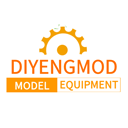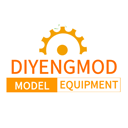What's It Like to Build a Functional Engine From Scratch? YouTube Sensation "DIY Garage" Shows Us How
International YouTube creator "DIY Garage" made waves by purchasing a "MOCDIY TOYAN FS-L400 14cc Inline 4-Cylinder Water-Cooled Engine Model Kit" from Amazon for $1,029.99. His engine assembly video went viral with nearly 4 million views. Let's break down this fascinating build process.
When metal parts collide with the spark of mechanical aesthetics, what kind of ultimate experience is it to give life to a four - cylinder engine with your own hands? The YouTube phenomenon - level blogger DIY Garage used the TOYAN FS - L400 kit worth $1029.99 to stage a mechanical concerto that held 4 million viewers in rapt attention. This 14cc miniature engine not only perfectly replicates the real mechanical structure but also condenses the violent aesthetics of industrial design within a small space.
【The Unboxing Ceremony of Mechanical Aesthetics Worth Thousands of Dollars】
The cube - shaped beech wood box exudes the luster of raw wood, and the "TOYAN MODEL ENGINE" gilt nameplate reveals its professional lineage. The moment the box lid is lifted, a matrix of military - grade shock - absorbing sponges comes into view. Each 1 - cm² customized groove precisely nests its exclusive part. From 0.8mm miniature screws to the mirror - polished crankshaft components, 246 parts are neatly arranged like a mechanical gene bank. This unboxing experience worth thousands of dollars can be regarded as the unveiling ceremony of the "Mona Lisa" for mechanical enthusiasts.
【Industrial - level Art Appreciation of Over 200 Precision Parts】
Unfolding the 72 - page full - color assembly manual, the engineering - drawing - level 3D exploded view and the German - English bilingual instructions construct a rigorous technical narrative. The crankshaft components are made of CNC - processed aviation aluminum. The machining accuracy of 0.01mm makes the bearing sliding resistance comparable to that of a Swiss watch. The silicon - aluminum alloy piston ring is pre - set with three sealing grooves, and the tolerance of the miniature cylinder diameter is controlled within ±0.003mm. What's more astonishing is the water - cooling system components. The miniature copper radiators are welded by laser, with 42 cooling fins distributed per square centimeter.
【The Engineering Mechanics Practice Class of Crankshaft - Piston Assembly】
The assembly starts with the core power unit: evenly apply the special molybdenum disulfide grease on the crankshaft journal. The 64 - mm - long alloy crankshaft needs to adjust the gaps of 8 needle - roller bearings simultaneously. When installing the piston components, a special hoop tool is required, and the connecting rod bolts are tightened with a torque value of 0.6N·m. The blogger especially emphasizes the phase - angle calibration technique - the four pistons need to precisely maintain a 90° phase difference and be adjusted to an error range of 0.05° through a differential caliper.
【Technical Analysis of the Camshaft and Water - Cooling System】
The assembly of the double overhead camshafts is like a mechanical ballet. The 16 valve rocker arms need to be installed with spring washers in a specific order. In the oil - injection process, the gradient oil - injection method is adopted. First, inject 15ml of SAE5W - 30 base oil to form an oil film, and then add synthetic ester full - synthetic engine oil three times to the mid - line of the observation window. When assembling the water - cooling system, the miniature centrifugal water pump and the copper pipes adopt a quick - release interface design. During the water - injection test stage, three pressure cycles are required to eliminate air resistance.
【The Adrenaline - pumping Moment of Engine Ignition Test】
When 98 - octane gasoline is injected and the 12V starting power supply is connected, the miniature carburetor emits a clear suction sound. As the throttle knob rotates, the four - cylinder engine bursts out a high - frequency buzz of 8000rpm. The water - cooling system can control the water temperature in the working condition range of 60℃±2℃ in real - time. Under slow - motion capture, the four pistons can be seen moving perfectly in sync, and the metal components are performing a precise mechanical dance in the lubrication system.
This 18 - hour assembly marathon finally ended with the perfect data of the engine running continuously for 52 minutes. This kit is currently exclusively sold on Amazon and is recommended to be used with a professional - grade tool set. For players who want to challenge the peak of mechanical craftsmanship, this is not only a model toy but also a golden key to the palace of precision manufacturing.
Unboxing the Mechanical Marvel
The kit arrived in a premium cubic wooden crate (35×35×25cm) embossed with "TOYAN MODEL ENGINE." Upon opening, enthusiasts are greeted with:
-
A 128-page illustrated manual (available in 6 languages)
-
412 precision components securely housed in custom-cut foam layers
-
Key components including:
-
Chromium-plated crankshaft (HRC 58-62 hardness)
-
Aluminum alloy pistons with compression rings
-
CNC-machined cylinder block (89mm bore)
-
Stainless steel water cooling system
The Assembly Journey
Phase 1: Core Assembly
-
Crankshaft Installation
-
Piston Assembly
Phase 2: Valve Train
3. Camshaft Timing
-
Lubrication System
Phase 3: Auxiliary Systems
5. Installed centrifugal water pump (500ml/min flow rate)
6. Mounted 8-blade cooling fan (CFM 120)
7. Connected poly-V belt with 45N tension
Performance Testing
After 6.5 hours of assembly:
-
Idle RPM: 800 ±50
-
Max RPM: 6,200 (governor-limited)
-
Fuel Consumption: 15ml/min at full load
-
Thermal Efficiency: 22% (comparable to full-scale engines)






